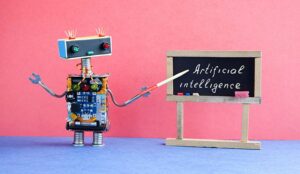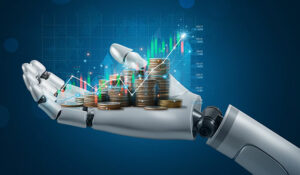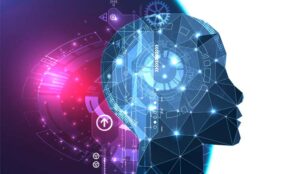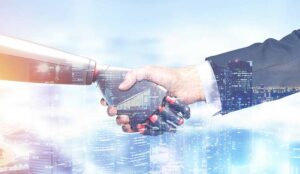Daniel Yin of RingCentral discusses the potential impact of artificial intelligence (AI) on the contact centre and beyond.
The global market for AI is projected to grow to a value of $89.8 billion by 2025, according to Statista. When you consider figures like that, it’s easy to see how AI could transform the future of work.
Artificial intelligence has the power to affect everything that we do. Already, it’s changing the way that we order products, manage our home, and gather information. According to the World Economic Forum, AI machines handled about 29% of the tasks across 12 industries in 2018.
By 2022, 62% of search and data processing tasks will be managed by machines. What’s more, another study from LinkedIn found that more people are adding AI skills to their profiles, highlighting the demand for people with a passion for algorithms.
Of course, a concept with as much power as artificial intelligence has both positives and negatives to consider. While fans of AI believe it could improve the way we work and empower everyday employees, others feel differently. There’s even a growing debate that AI could destroy the future workplace by eliminating human jobs.
So, what’s the truth?
What Is Artificial Intelligence?
Artificial intelligence, or AI, refers to robotic algorithms and machines that can simulate human intelligence. These machines can “learn” by gathering information, use rules for reasoning, and even correct themselves when they make mistakes.
In the workplace, AI exists in everything from chatbots to intelligent speech recognition systems.
There are many different ways to design an AI system. Some stronger systems are beginning to rely less on human intervention. It’s these systems that lead to worries about robotic singularity. Some companies are even starting to introduce AI as an add-on service over the cloud. After all, Gartner predict that AI augmentation will generate $2.9 trillion in business value by 2021.
Artificial intelligence tools can transform the future workplace, by reducing repetitive work and supporting employees. Some of the common forms of technology we see AI include:
- Machine learning: A solution that encourages computers to act without programming assistance or human intervention.
- Automation: Robotic programming automation tools can perform repeatable high-volume tasks that give humans more time.
- Natural language processing: Identifying human language to support data-gathering processes and customer service.
How Are Businesses Using AI Today?
When evaluating the impact that artificial intelligence may have on the future of work, it’s essential to explore the practical uses it has in business.
We can use AI in a host of different ways, from placing bots in our collaboration apps to help schedule useful meetings to enhancing our IVR systems.
As reported in Forbes, around 63% of companies think that the pressure to reduce costs will push them to invest in artificial intelligence going ahead. And another 54% of executives say that the AI solutions they’ve already adopted have increased productivity – according to PwC research.
Here are some of the most impactful ways that AI is changing the future of work:
1. Fighting Fraud and Cybercrime
Countless companies are struggling in the ongoing war against cybercrime. Fraud detection depends heavily on the ability to recognise patterns. Machines are capable of detecting trends in behaviour and application usage. Companies are already using machine learning techniques to develop solutions that help companies to identify suspicious activities.
Though it will take time to perfect cybersecurity solutions that allow companies to fight cybercrime, tools are becoming increasingly powerful. Some AI can even detect specific nuances in a person’s voice and use biometric markers to prevent fraud.
2. Conversational AI
The rise of conversational AI is also particularly relevant to the future of work. Companies are developing speech-based assistants like Amazon Alexa that are capable of responding to human language, as well as IVR systems and chatbots.
Through conversational AI, businesses can deliver an enhanced experience to their customers, while taking some of the stress away from human employees. Conversational AI improves the interactions you can have with your consumers through multiple touchpoints.
Currently, according to Forbes, the industry is set to reach a value of $11 billion by 2023.
3. Bots and Virtual Assistants
Increasingly, machine learning algorithms and artificial intelligence are moving beyond the basic understanding of the text. Today’s machines can also derive meaning from speech, pictures, and video. These systems are the basis of the virtual assistants that employees can use to streamline work performance.
Virtual assistants have the power to do a range of things for today’s companies. They can order supplies the moment they notice that the system is running low. Chatbots can also set up meetings and automate reminders for workers. Once in a meeting, a bot can even take notes and offer real-time transcriptions.
Many leaders in the artificial intelligence space believe that virtual assistants will transform the future workplace by giving every employee the support they need.
The Advantages of AI Tech in the Future Workplace
There’s no one-size-fits-all strategy to using artificial intelligence for the future of work.
The way you implement solutions will depend on which parts of your business need the most support. Effective AI strategies emerge when you start by defining employee pain points then work backwards. Artificial intelligence can enhance everything from data analysis to customer experience.
Huge organisations like Walmart are already using artificial intelligence to address things like data analytics and make more informed data-driven decisions.
How Can You Use AI to Positively Influence the Future of Work?
1. Reducing Costs
As reported in Business Wire, 80% of tech and business leaders believe that AI improves productivity. More productive employees mean better customer service and improved revenue. It can also eliminate the repetitive tasks that cost staff members time, and business leaders money.
If a task can be broken up into simple sub-tasks, then most of those tasks can be automated. For instance, machines can review security footage to look for specific indicators of suspicious activities.
These tools can also automatically renew and request materials in a supply chain. When computers handle the boring and repetitive tasks in a workplace, human beings have the freedom to focus on more creative jobs and unlock their real potential.
2. Improving Efficiency
When it comes to the future workplace, voice assistants don’t replace anyone’s jobs. Instead, they’re there to add more value to the people who are already employed within a team. For instance, a virtual assistant in the office collaboration tool can automatically manage tasks, adapt schedules, set up meetings and more. This means that employees have more time to work on the projects that matter most to them.
3. Better Customer Service
Customer experience is the most critical differentiator in any business today. Customers don’t judge a company by the price of their products or the range of services that they offer. Instead, your clients want to know that you will deliver the experience that they need on any platform.
Unfortunately, it’s notoriously difficult for companies of all sizes to keep track of their customers across everything from SMS to instant messaging, phone calls, and more.
Artificial intelligence can deliver an era of better customer experience by ensuring people get the right response at the right time. Intelligent chatbots and IVR solutions answer simple customer questions and send complex queries to the correct agent using smart routing. The result is happier customers and less stressed employees.
How to Implement Artificial Intelligence in Your Workplace
Smart technology isn’t just changing our homes any more. These tools are quickly making their way into numerous industries around the world, disrupting the future of work. Many fear that artificial intelligence will lead to machines taking over from humans. However, the truth is that robotics can be a powerful addition to the workplace. All you need to do is figure out how you’re going to use the technology correctly.
1. Focus on AI to Complement, Not Replace
Perhaps the biggest fear associated with the future workplace and AI is that the technology will eliminate the value of humans in the office. However, while it’s true that intelligence can reduce the need for costly human labour, the aim is rarely to replace people completely.
People still demand the option to talk to human beings when they’re looking for customer service. Capgemini studies have even found that AI leads to increases in job opportunities, alongside improved service and enhanced efficiency. Think about how AI can complement, not replace, your day-to-day operations, and go from there.
2. Educate Both Your Team and Yourself
New technologies and innovations usually come with some manner of knowledge gap. While there are definitely early adopters out there, there’s a good chance that you’re going to need basic education to get you started with artificial intelligence.
With AI set to have a significant impact on the workforce in the next five years, it’s important to think carefully about what kind of tools you need. The aim shouldn’t be to simply implement the latest tools because they’re novel and exciting. Look for strategies that will deliver measurable insights for your business.
3. Work With Specialists
When you’re looking for a vendor to support your artificial intelligence strategy, search for a company that can offer guidance. Leading businesses like RingCentral can help you with the training and insights you need to see how artificial intelligence will have a positive impact on the future of work for your company.
You’ll also need a brand like RingCentral to ensure that you can adjust your artificial intelligence strategies dynamically to suit your needs. Make sure that you’re capable of adding new solutions and services as your organisation continues to grow.
Will Humans and Machines Be Able to Work Side by Side in the Future?
For many companies today, artificial intelligence represents an exciting opportunity to improve efficiency and enhance business performance. However, it’s hard to overlook the growing fear that these tools will also destroy the future of work for many employees. The concern that artificial intelligence will automate and eliminate jobs has been growing over the years.
One Oxford study claimed that around 47% of US workers may see their jobs being automated in the next 20 years. However, while it’s difficult to predict the future, the truth is that it’s unlikely that bots will ever replace human beings.
Although artificial intelligence tools can definitely supplement human workers and make it easier for them to complete their tasks, there will always be a need for human creativity, innovation, compassion and intuition in the workplace.
Artificial intelligence can do a lot of things, but bots can’t completely replace or imitate human workers. More often than not, these tools will instead be implemented to give more power back to human employees, by automating the tasks that take up too much of their time.
What’s more, artificial intelligence is also creating a slew of new jobs in many areas that weren’t around before. STEM data scientists are incredibly sought-after today, but they barely existed a decade ago.

Daniel Yin
Although some experts predict that certain repetitive jobs may be wiped out one day in the future, Gartner believes that artificial intelligence will create more jobs than it destroys. For now, the relationship between human workers and AI is likely to be a symbiotic one.
For the future workplace to be successful, it’s likely that humans and bots will need to work together to facilitate positive outcomes. Instead of worrying about the singularity, it might be time to start considering the concept of multiplicity, where combinations of machines and people can work together to create innovations that we couldn’t have possibly imagined before.
Author: Robyn Coppell
Published On: 20th May 2019 - Last modified: 22nd May 2019
Read more about - Guest Blogs, RingCentral


































